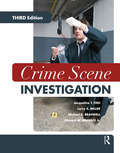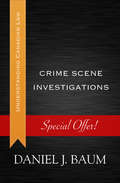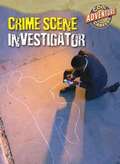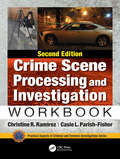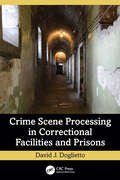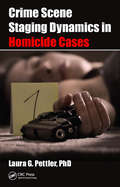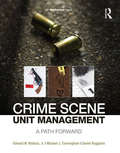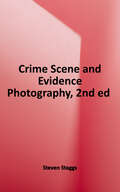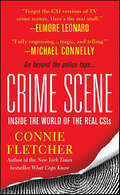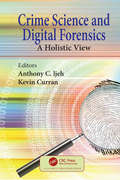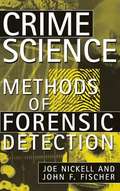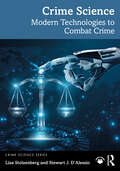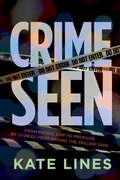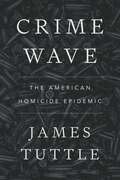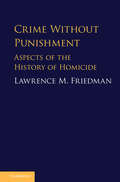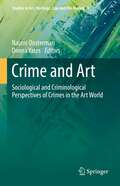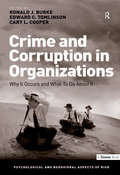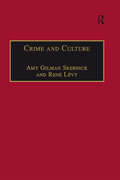- Table View
- List View
Crime Scene Investigation: Step By Step From The Crime Scene To The Courtroom
by Larry S. Miller Michael C. Braswell Jacqueline T. Fish Edward W. WallaceCrime Scene Investigation offers an innovative approach to learning about crime scene investigation, taking the reader from the first response on the crime scene to documenting crime scene evidence and preparing evidence for courtroom presentation. It includes topics not normally covered in other texts, such as forensic anthropology and pathology, arson and explosives, and the electronic crime scene. Numerous photographs and illustrations complement text material, and a chapter-by-chapter fictional narrative also provides the reader with a qualitative dimension of the crime scene experience.
Crime Scene Investigations
by Daniel J. BaumWhen police are called in to investigate a crime, what powers and limitations apply to them? What are their rights to question strangers, search without warrants, or detain individuals who might become suspects? Crime Scene Investigations breaks down the Supreme Court's decisions on questions like these into clear and practical terms. Police need to be vigilant, since the line between a lawful search and an improper one can be dangerously thin, and officers can be held accountable for any wrongdoing, intentional or not. The controversy surrounding such techniques as "stop-and-frisk" sweeps and compulsory DNA testing underscores the importance of understanding the legal dimensions of police powers. Because interactions between law enforcement officers and civilians are often charged with complexities, Crime Scene Investigations provides a level-headed guide, indispensable for those on either side of an investigation.
Crime Scene Investigator (Cool Adventure Careers)
by Geoffrey M. HornThe first group of titles in an ongoing series introduces students to six amazing adventure careers. Geared for reluctant readers in upper elementary school and above, each high-interest title combines easy-to-follow text with engaging on-the-job photos to spark students' interest in reading and career exploration. Each book is filled with descriptive information about the career, along with the skills and requirements needed to pursue a job in the profiled field.
Crime Scene Photography (Second Edition)
by Edward M. RobinsonCrime Scene Photography, Second Edition covers the general principals and concepts of photography, while also delving into the more practical elements and advanced concepts of forensic photography. Edward Robinson assists the reader in understanding and applying essential concepts in order to create images that are able to withstand challenges in court. The first part of the book deals with the basic theory and science of photography required to take superior photographs, and covers topics such as composition, exposure, focus, depth of field, and flash techniques. The second part of the text deals specifically with the challenges of photographing a crime scene, including instructions on how to document bodies and wounds, traffic accident photography, underwater photography and aerial photography. In the latter portions of the text, the author turns to digital theory and its advantages and disadvantages. * Over 600 full color photographs, also electronically available on the companion website * Two new chapters on 'The History of Forensic Photography,' and 'Digital Image Processing of Evidentiary Photography' * Includes an Instructor website with lecture slides, practical exercises, a test bank and image collection * An essential reference for crime scene photography, including topics such as Composition, the Inverse Square Law, Court Cases affecting photography, Digital Image Processing, and Photogrammetry * Required reading by the Crime Scene Certification Board of the International Association for Identification (IAI) for all levels of certification
Crime Scene Processing and Investigation Workbook, Second Edition
by Christine R. Ramirez Casie L. Parish-FisherCrime Scene Processing and Investigation Workbook, Second Edition is the only workbook which directly supports and cross-references methodology and terminology presented in Ross Gardner and Donna Krouskup’s perennial best-seller Practical Crime Scene Processing and Investigations, Third Edition. The workbook serves as supporting material offering hands-on activities to supplement theories and methodologies within the text as well as updated activities to support the new material presented in the Third Edition. As the number of forensic academic programs within the United States continue to grow—and the textbook continues to be a go-to standard in the field—the workbook remains an invaluable reference for academics, forensic training providers, and law enforcement training programs. The detailed Instructor’s Manual (IM) lends itself not only to experts who have utilized these procedures before but also to the novice and student who may be introduced to these topics in a classroom setting for the first time. The workbook conducts over 30 activities with detailed instructions, concept overviews, and reflective post-lab questions. Crime Scene Processing and Investigation Workbook, Second Edition, continues to stand as the best workbook on the market, addressing foundational principles in a hands-on manner while directly correlating to the concepts addressed in the Gardner and Krouskup textbook.
Crime Scene Processing and Laboratory Workbook
by Patrick Jones Ralph E. WilliamsThe most important part of a CSI‘s (crime scene investigator) job is accurate documentation of properly collected evidence. Documentation tells the story of the crime and can ultimately prove a suspect guilty. Through an array of specific exercises and actual document templates used in practice, Crime Scene Processing and Laboratory Workbook teache
Crime Scene Processing in Correctional Facilities and Prisons
by David J. DogliettoCrime scenes within correctional facilities present investigators with myriad challenges, not only in working, investigating, and collecting evidence but also in obtaining reliable eyewitness accounts. As a result, they are some of the most challenging cases and environments that any investigator will encounter.Crime Scene Processing in Correctional Facilities and Prisons addresses the unique challenges in prison, correction, and detention facilities, outlining specific procedures and techniques that will reliably improve any investigation. Issues of contaminated crime scenes can result from guards trying to regain order, few to no dedicated staff with no training or understanding of crime scenes, a lack of cooperation from witnesses and victims, and even the lack of cooperation from the on-scene incident commander – whose main objective may be to return the facility to “normal” rather than allow for the proper collection of evidence. Whatever the challenges faced, this book tackles all of them. While the processing of crime scenes entails standard procedures and practices, a correctional setting can provide anything but. As a result, the investigator must be resourceful, tenacious – yet patient – and perform their duties with objectivity and ethical integrity throughout the process.Features: Serves as the only resource on the market to provide essential investigative and crime scene guidelines unique and specific to correctional facilities Presents the various challenges of gathering and preserving evidence and investigating crimes, in correctional settings – including federal and state prisons, jails, and detention facilities In addition to presenting best practices in handling evidence and investigative procedures, covers unique interview techniques, report writing, and expert testimony Author David Doglietto, as an experienced professional with decades of first-hand experience, walks readers through the best way to perform duties to cut through the challenges and barriers and avoid the pitfalls that come with the oftentimes complex investigations in these environments. Extensive illustrations and case examples are provided within the book, as chapters present best-practice investigative practices in an environment for which there is little published resource and reference material. Crime Scene Processing in Correctional Facilities and Prisons is an invaluable resource for crime scene investigators, legal professionals, and the staff, leadership, and managers of correctional facilities themselves.
Crime Scene Staging Dynamics in Homicide Cases
by Laura Gail PettlerIndividuals who perpetrate murder sometimes pose or reposition victims, weapons, and evidence to make it look like events happened in a different way than what actually transpired. Until now, there has been scarce literature published on crime scene staging.Crime Scene Staging Dynamics in Homicide Cases is the first book to look at this practice, p
Crime Scene Unit Management: A Path Forward
by Edward W. Wallace Michael J. Cunningham Daniel BoggianoCrime Scene Unit Management: A Path Forward is a must-have resource for anyone involved with forensic investigations and the search for evidence at the crime scene. The book provides standards for how to manage a crime scene so that evidence is collected and preserved without errors and includes guidelines for how to implement the standards and set up regional training programs for smaller jurisdictions with tighter budgets. Key features include examples, checklists, and flow charts for evidence handling and routing. CSIs, fire investigators, homicide investigators, accident investigators, police executives, and students of forensic science will benefit from this thorough approach to how the crime scene—and the personnel charged with tending to the evidence—should be managed.
Crime Scene and Evidence Photography
by Steven StaggsThis book is designed for those responsible for photography at the crime scene and in the laboratory. It may be used by law enforcement officers, investigators, crime scene technicians, and forensic scientists. It contains instructions for photographing a variety of crime scenes and various types of evidence. It is a valuable reference tool when combined with training and experience. Crime Scene and Evidence Photography is also a helpful resource for students and others interested in entering into the field of crime scene investigation.
Crime Scene: Inside the World of the Real CSIs
by Connie FletcherMost people who work as actual crime scene investigators will tell you two things: Television doesn't always show the truth...and science never lies. But how do DNA experts, trace analysts, medical examiners, forensic pathologists, and cold case detectives work together to produce evidence and solve a case—beyond the shadow of a doubt? In this fascinating, true-life account, America's leading crime experts share their personal, unforgettable stories. From powder burn to fiber analysis, blood spatter to skeletal remains, New York Times bestselling author Connie Fletcher takes you into a world of crime-solving that's even grittier, more bizarre, and more shocking than any TV show. It's a thrilling ride into the dead center of a crime scene.
Crime Science and Digital Forensics: A Holistic View
by Anthony C. IjehThis volume is a collation of articles on counter forensics practices and digital investigative methods from the perspective of crime science. The book also shares alternative dialogue on information security techniques used to protect data from unauthorised access and manipulation. Scandals such as those at OPCW and Gatwick Airport have reinforced the importance of crime science and the need to take proactive measures rather than a wait and see approach currently used by many organisations. This book proposes a new approach in dealing with cybercrime and unsociable behavior involving remote technologies using a combination of evidence-based disciplines in order to enhance cybersecurity and authorised controls. It starts by providing a rationale for combining selected disciplines to enhance cybersecurity by discussing relevant theories and highlighting the features that strengthen privacy when mixed. The essence of a holistic model is brought about by the challenge facing digital forensic professionals within environments where tested investigative practices are unable to provide satisfactory evidence and security. This book will be of interest to students, digital forensic and cyber security practitioners and policy makers. It marks a new route in the study of combined disciplines to tackle cybercrime using digital investigations and crime science.
Crime Science: Methods of Crime Detection
by Joe Nickell John F. FischThis method is empirical (from the Latin empiricus, "experienced"), meaning that knowledge is gained from direct observation.
Crime Science: Modern Technologies to Combat Crime (Crime Science Series)
by Lisa Stolzenberg Stewart J. D'AlessioThis book comprehensively examines the rapidly changing tactics and technologies used to combat crime. The authors delve into the intricacies of how scientific methodologies and technological advancements are employed to investigate and prevent various forms of crime, exploring topics such as forensic science, cybercrime, data analytics, crime mapping, predictive policing, and other technological and scientific advancements that aid law enforcement and criminologists in their work. It explores the interplay between criminology, technology, and science and arms readers with knowledge about cutting-edge techniques and technologies utilized in the fight against crime. Through engaging narratives, case studies, and expert insights, this book sheds light on the intricate web of scientific disciplines that play a pivotal role in uncovering and solving crimes. The technologies covered represent a complex web of tools available to law enforcement and other criminal justice agencies. However, it is important to recognize that integrating these technologies requires careful consideration of legal, ethical, and social issues, including privacy rights and potential biases in predictive algorithms. As technology continues to evolve, so will the tools available for crime prevention, detection, and prosecution. It is an ongoing process of balance and adjustment as society seeks to ensure safety and justice while preserving individual rights and freedoms. Appropriate as a textbook for crime science, criminal investigation, and crime prevention courses in criminology and criminal justice programs, Crime Science: Modern Technologies to Combat Crime is also useful for professionals and others intrigued by the world of crime and investigation. This book is a groundbreaking exploration into the important role science plays in comprehending, preventing, and solving crimes in the modern era.
Crime Seen
by Kate LinesA criminal profiler, trained at Quantico, former Chief Superintendent of the Ontario Provincial Police (OPP) Kate Lines recounts her remarkable story using pivotal cases she worked on in the course of her career. How does a farm girl from Ennismore enter a male-dominated field and become a top criminal profiler and groundbreaking leader? For Kate Lines, it started humbly, patrolling highways. She learned quickly that the best way to thrive was to keep calm, carry on and never lose her sense of humour. In what would be the first of many dramatic turns in her career, Kate traded in her uniform for a tight miniskirt and a leather jacket, becoming one of the OPP's first female undercover officers. In 1990 came the opportunity of a lifetime: to be chosen as the 2nd-ever Canadian in an elite program at Quantico, Virginia in what was then the emerging field of criminal profiling. After 10 months of an intensive education in the intricacies of violent crime, Kate's new skills made her much in demand back home. Over the years she was involved in a number of high-profile cases, such as the abduction and murder of Kristen French and of Tori Stafford and the disappearance of Michael Dunahee. Kate was an early proponent of ViCLAS--the Violent Crime Linkage Analysis System, and when she took charge of the new and massive Behavioural Sciences division in Orillia, she took over ViCLAS and turned the department into a hub of innovation. Kate was awarded a Governor General's medal for being in the top 1/10th of 1% of the members of police forces that year. The following year the Canadian Police Leadership Foundation named her Police Leader of the Year. Always taking care not to aggrandize in any way the criminals whose names we may know all too well, Kate feels it's much more important to focus on the courage of victims and their families. Kate is an unsung, groundbreaking Canadian woman, one of a kind in this country, with a unique, inspiring and fascinating story to share.
Crime Victim Rights and Remedies 2nd edition
by Peggy M. Tobolowsky Mario T. Gaboury Arrick L. Jackson Ashley G. BlackburnThe authors describe the constitutional and legislative provisions addressing the principal crime victim rights and remedies and leading judicial opinions that have interpreted them. In addition to presenting the current state of law in this area, the text describes the status of implementation of these rights and remedies, relevant empirical research, and a sampling of the pertinent policy analysis. This comprehensive portrait of the past and current status of crime victims rights and remedies in this country will inform the continued evolution of law and practice in this area. The second edition of Crime Victim Rights and Remedies will continue to address the evolution of key crime victim rights (e. g. , the rights to notice of and to be present and heard at criminal justice proceedings) and will include the state constitutional amendments, legislation, court decisions, and empirical studies completed since the first edition in 2001. Of particular note will be an expanded federal section regarding each right and remedy reflecting the Crime Victims' Rights Act, enacted in 2004, and court decisions that have interpreted it thus far.
Crime Victims: An Introduction To Victimology (Ninth Edition)
by Andrew KarmenA first in the field when initially published and now a true classic, CRIME VICTIMS: AN INTRODUCTION TO VICTIMOLOGY, Ninth Edition offers the most comprehensive and balanced exploration of victimology available today. The author examines the victims' plight, carefully placing statistics from the FBI's Uniform Crime Report and Bureau of Justice Statistics National Crime Victimization Survey in context. At the same time, he "humanizes" victims' stories through compelling case studies. The text systematically investigates how victims are currently handled by the criminal justice system, analyzes the goals of the victims' rights movement, and discusses what the future is likely to hold. This Ninth Edition presents current coverage of the seriousness of intimate partner violence, child abuse, sexual assaults in the U. S. military, acquaintance rapes on college campuses, shootings on campuses, whether arming for self-protection is an effective strategy, and similar high-profile issues. It also includes new information about "survivorology" and "bystanderology" as well as new material on practical issues facing victims.
Crime Wave: The American Homicide Epidemic
by James TuttleWhy homicides have increasedThe homicide rate in the United States increased by approximately 55 percent from 2014 to 2021. An initial spike in homicide rates began in 2015, and the rate continued on its generally upward trajectory through subsequent years, eventually increasing by the largest annual margin in recorded history during 2020. By 2021, several cities and states recorded homicide rates higher than during the crime-plagued 1990s. Why did America suddenly become more violent?James Tuttle examines the underlying causes behind this surge in violence, arguing that it is the result of the decline in American well-being, a growing distrust in institutions, an increase in alcohol and drug abuse, and escalating firearm sales. Tuttle also shows how the homicide epidemic has hit different parts of the country; notably there has been an increase in homicide in the Midwest that is 25 percent greater than in the rest of the country.Through comprehensive analysis of the most recent crime data available, Tuttle provides compelling evidence supporting these contentions, illuminating the intricate relationship between societal decline and the homicide epidemic. This book builds on evidence that demonstrates the limited impact of police tactics on crime rates, and finds little substantiation for the notion that police department defunding played a role in the rise of crime across American cities. Crime Wave attempts to reframe the public debate beyond the current “police-only” paradigm of explaining crime trends by examining the broader social and cultural forces that shape American violence.
Crime Without Punishment: Aspects Of The History Of Homicide
by Lawrence M. FriedmanIn this compelling book, Lawrence M. Friedman looks at situations where killing is condemned by law but not by social norms and, therefore, is rarely punished. <P><P>He shows how penal codes categorize homicides by degree of intent, which are in turn based on society's sense of moral outrage. Despite being officially defined as murder, many homicides have historically gone unpunished. Friedman looks at early vigilante justice, crimes of passion, murder of necessity, mercy killings, and assisted suicides. In his explorations of these unpunished homicides, Friedman probes what these circumstances tell us about conflicts in social and cultural norms and the interaction of law and society.<P> Asks when, if ever, killing can justifiably be considered as homicide.<P> Connects seemingly different examples of 'crimes without punishment' with historical developments.<P> Links research on the history of criminal justice with the way in which legal systems actually operate in society today.
Crime and Art: Sociological and Criminological Perspectives of Crimes in the Art World (Studies in Art, Heritage, Law and the Market #1)
by Donna Yates Naomi OostermanThis volume brings together work by authors who draw upon sociological and criminological methods, theory, and frameworks, to produce research that pushes boundaries, considers new questions, and reshape the existing understanding of "art crimes", with a strong emphasis on methodological innovation and novel theory application. Criminologists and sociologists are poorly represented in academic discourse on art and culture related crimes. However, to understand topics like theft, security, trafficking, forgery, vandalism, offender motivation, the efficacy of and results of policy interventions, and the effects art crimes have on communities, we must develop the theoretical and methodological models we use for analyses. The readership of this book is expected to include academics, researchers, and practitioners in the fields of criminology, sociology, law, and heritage studies who have an interest in art and heritage crime.
Crime and Corruption in New Democracies
by Jon MoranCovering countries as diverse as Brazil and Guatemala, Thailand, Russia and occupied Iraq, this book examines the way democratization may lead to changes in crime. Case studies examine violent and sexual crime and their links to political change. The book also explores the way democracy itself may generate cycles of violence sometimes greater than the previous regime as states adopt hard-line policies to crime. However, the author sets democracy and crime in perspective, arguing that organized crime is not the threat to democracy many policy makers and academics claim. Generally, whilst crime and corruption are changed by democratization and crime may rise markedly, democracies are remarkably resilient. This book also examines democratization and corruption, and provides a new perspective on the relationship between the two, arguing that political power has been sidelined in explanations of corruption.
Crime and Corruption in Organizations: Why It Occurs and What To Do About It (Psychological and Behavioural Aspects of Risk)
by Ronald J. Burke Edward C. TomlinsonAlthough increasing attention has been paid to it, there are no signs that crime and corruption in organizations is decreasing, so if you're a manager or government policy maker, and your mandate is to reduce crime and corruption, where do you start? The international authors of this book fill a critical need to address such a prevalent and costly topic with a detailed analysis of the risks associated with crime and corruption in organizations. They examine the causes and consequences, and the choices we face in our efforts to eradicate these social maladies. They focus on the risks to individuals and organizations surrounding criminal and corrupt acts, with an emphasis on the psychological, behavioral and organizational factors supporting such behaviors. Finally, they explore the phenomenon of crime and corruption across a diverse array of organizational settings (ranging from public to private, for-profit to non-profit) and occupational categories (e.g., police officers, physicians, accountants, and academicians). The constant barrage of scandals publicized by the media demands 'front burner' attention dedicated to stemming this tide. Accordingly, this book turns to prominent researchers employing their talents to produce more ethical organizations. The result is the most up-to-date thinking on both classic (e.g., cognitive moral development) and novel (e.g., moral attentiveness) approaches to crime and corruption, as well as scientifically-grounded approaches to reducing illicit behavior in organizations.
Crime and Criminal Justice in Modern Germany (Studies in German History #16)
by Richard F. WetzellThe history of criminal justice in modern Germany has become a vibrant field of research, as demonstrated in this volume. Following an introductory survey, the twelve chapters examine major topics in the history of crime and criminal justice from Imperial Germany, through the Weimar and Nazi eras, to the early postwar years. These topics include case studies of criminal trials, the development of juvenile justice, and the efforts to reform the penal code, criminal procedure, and the prison system. The collection also reveals that the history of criminal justice has much to contribute to other areas of historical inquiry: it explores the changing relationship of criminal justice to psychiatry and social welfare, analyzes representations of crime and criminal justice in the media and literature, and uses the lens of criminal justice to illuminate German social history, gender history, and the history of sexuality.
Crime and Criminology
by Ph. D. Reid Sue TitusKnown for its unique blend of social science and legal research, Crime and Criminology, Fifteenth Edition uses an interdisciplinary approach to bring a sprawling subject into sharp relief. From the history and theory of criminal law to today’s hot-button topics, leading scholar Reid clearly explains to students how criminology affects and relates to criminal justice policies.
Crime and Culture: An Historical Perspective (New Advances in Crime and Social Harm)
by AMY GILMAN SREBNICK AND RENÉ LÉVYScholarly interest in the history of crime has grown dramatically in recent years and, because scholars associated with this work have relied on a broad social definition of crime which includes acts that are against the law as well as acts of social banditry and political rebellion, crime history has become a major aspect not only of social history, but also of cultural as well as legal studies. This collection explores how the history of crime provides a way to study time, place and culture. Adopting an international and interdisciplinary perspective to investigate the historical discourses of crime in Europe and the United States from the sixteenth to the late twentieth century, these original works provide new approaches to understanding the meaning of crime in modern western culture and underscore the new importance given to crime and criminal events in historical studies. Written by both well-known historians and younger scholars from across the globe, the essays reveal that there are important continuities in the history of crime and its representations in modern culture, despite particularities of time and place.
